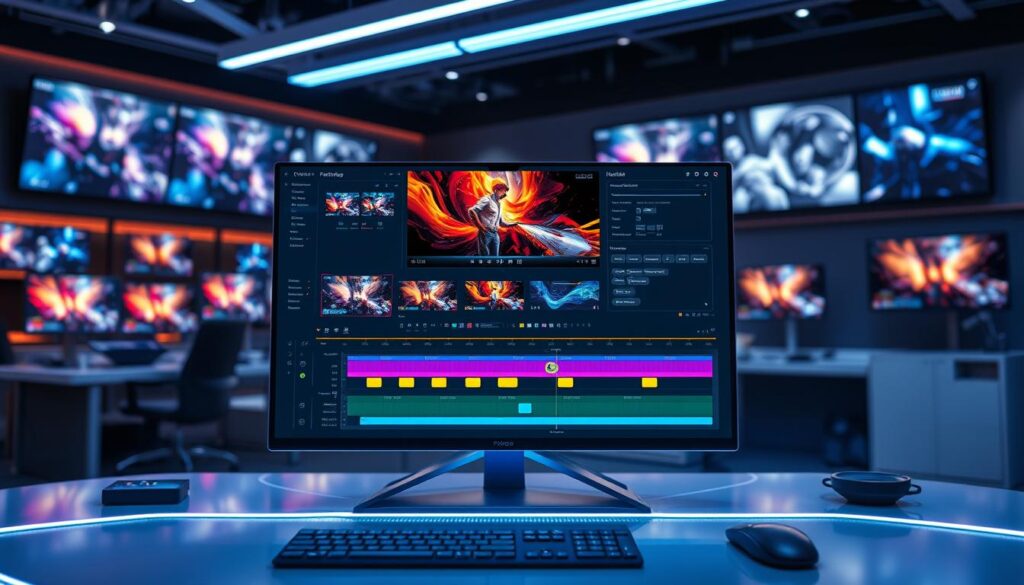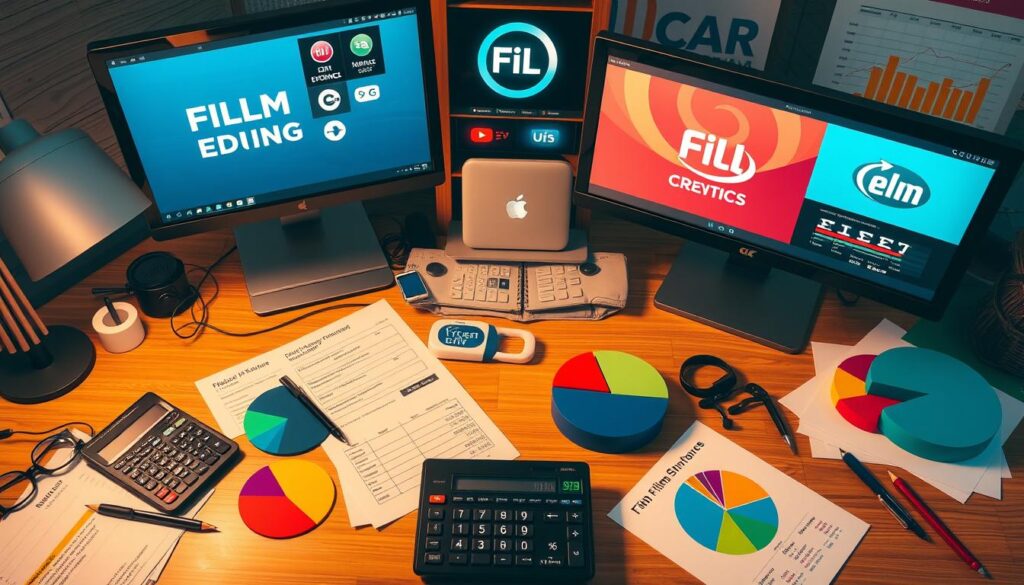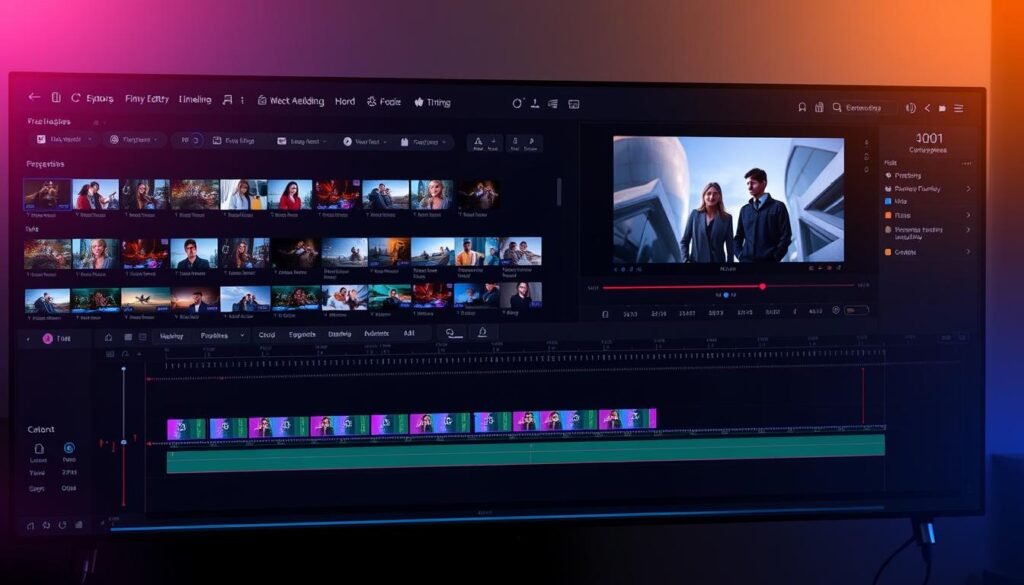In the world of film editing, picking the right software is key. It matters for both new filmmakers and seasoned pros. Today, there’s a wide range of editing tools thanks to tech advances. These tools suit all skill levels, from easy-to-use options for beginners to complex systems for experts.
Knowing which software is used in the industry can really make a difference. It can change how a movie looks and feels. We’ll explore the many choices out there and why they matter in film editing.
Key Takeaways
- The choice of film editing software is vital for enhancing video projects.
- Technological advancements have expanded the variety of editing tools available.
- Understanding different software options helps in selecting the right tools for specific needs.
- Film editing software varies from beginner-friendly to industry-standard solutions.
- The right software can positively influence the final product of a film.
Introduction to Film Editing Software
Film editing software is key in creating visual stories. The introduction of digital tools changed the game, moving from old tape editing to new software. Now, filmmakers have many options, from simple projects to big productions.
Today, editors use many film editing software tools. These tools help them cut, arrange, and change video footage easily. This makes the work faster and better. Modern software also lets users add sound, graphics, and effects, making the final product better.
As technology gets better, so do film editing software tools. These updates help storytellers reach their goals without spending too much. Now, editors can pick software that fits their needs, whether for big movies or personal projects.
| Features | Basic Software | Advanced Software |
|---|---|---|
| User Interface | Simple and Intuitive | Complex with Diverse Functions |
| Editing Tools | Basic Cutting and Trimming | Multi-Layer Editing and Effects |
| Export Options | Standard Formats | Various Formats including High-Resolution |
| Learning Curve | Minimal Skill Needed | Requires Advanced Knowledge |
Importance of Choosing the Right Film Editing Software
Choosing the right film editing software is key to a project’s success. It affects everything from how fast you work to the film’s look. Knowing the differences between programs helps editors match their skills with their project’s needs.
When picking editing software, think about a few things. The software’s ease of use and how it looks can make your work faster. If you can use your tools well, you’ll spend less time fixing problems and more time being creative.
Also, how well the software works with other tools is important. This ensures everything runs smoothly from start to finish.
The features a software has are crucial for best editing practices. Good software lets you edit in many ways, add cool effects, and format well. This helps you work faster and make your project better.
Industry-Standard Film Editing Software
Professional film editing software is key in making movies. It boosts the creativity and skill of editors. There are top software options known for their strong features and reliability. They meet different needs in film editing.
Adobe Premiere Pro
Adobe Premiere Pro is a favorite among filmmakers. It works well with other Adobe tools like After Effects and Photoshop. Its easy-to-use interface lets editors do advanced editing and supports many video formats.
Editors love its flexibility, a big library of plugins, and teamwork features. Some might find it heavy on resources. But its many abilities make it a top choice for editing.
Avid Media Composer
Avid Media Composer is known for its strong editing tools. It’s great for making feature films and TV shows. It has top-notch tools for audio, color correction, and working with multiple cameras.
Big studios like it for its reliability and teamwork features. It might be hard to learn at first. But many pros see it as essential for top video production.
Final Cut Pro X
Final Cut Pro X is easy to use and manages timelines well. It’s good for both new and experienced editors. Its magnetic timeline helps focus on the story without worrying about track management.
It’s only for macOS, but it has great features like advanced color grading and 360-degree video editing. Users like its fast performance, making it a strong competitor.
Popular Free Film Editing Software Options
Filmmakers often look for budget-friendly tools to make great content without spending a lot. DaVinci Resolve and HitFilm Express are top picks for free film editing software. They have great features for both new and experienced editors.
DaVinci Resolve
DaVinci Resolve is famous for its amazing color grading tools. It lets filmmakers make their projects look stunning. It also has professional editing, audio post-production, and visual effects. It’s perfect for those who want to learn more about film editing without spending a lot.
HitFilm Express
HitFilm Express mixes basic editing with advanced visual effects. It has lots of editing options for making professional films. It’s great for those who want budget-friendly tools and to learn creative ways to tell stories with visuals.
DaVinci Resolve and HitFilm Express show that making great films doesn’t have to cost a lot. With these free film editing software options, new filmmakers can improve their work without worrying about money.
| Software | Key Features | Best For |
|---|---|---|
| DaVinci Resolve | Professional color grading, advanced audio editing, extensive effects library | Creatives focused on visual storytelling |
| HitFilm Express | Visual effects integration, motion graphics, customizable interface | Filmmakers combining editing with visual effects |
Understanding Film Editing Workflows
Film editing workflows are key to the editing process. They help filmmakers organize their projects well. This makes the editing process more efficient.
The first step is video ingestion. Here, raw footage is brought into the editing software. Then, comes organization, where clips are sorted and labeled. This makes finding footage easier later on.
Next, editors cut and assemble the footage. They remove unwanted parts and create a smooth story. Advanced tools help with transitions and effects, making everything fit together perfectly.
Finally, sound design and color grading add the final touches. These steps make the project look and sound professional.
Learning about film editing workflows is crucial. It helps filmmakers create a polished final product. With the right workflow and tools, they can make each project better and more efficient.
Which software is used in film editing?
Film editing needs different software for various skill levels and projects. The right software used greatly affects the editing quality and speed. There are tools for all, from beginners to pros.
Adobe Premiere Pro and Avid Media Composer are top choices. They offer many features and support high-resolution editing. These are great for big projects.
DaVinci Resolve and HitFilm Express are good for those watching their budget. They have lots of features but cost less. They’re perfect for new editors or hobbyists.
New cloud-based platforms like WeVideo and Adobe Spark are also popular. They make teamwork easy. Knowing these tools helps filmmakers pick the best for their needs.
Cloud-Based Film Editing Software
Technology has changed how we edit films, moving towards cloud-based solutions. These options make editing more accessible, collaborative, and easy to use. We’ll look at WeVideo and Adobe Spark, two cloud-based tools designed for today’s filmmakers.
WeVideo
WeVideo is a top online editing tool for real-time collaboration. It has a simple interface for all creators. Its main features are:
- Access from any device with internet
- Robust cloud storage for seamless project management
- Integration with various media libraries for convenient access to resources
- Real-time collaboration, making teamwork efficient
Adobe Spark
Adobe Spark leads in cloud-based editing, focusing on quick video creation. It’s perfect for those who need speed and simplicity. Its key features are:
- Templates for creating videos quickly
- Cross-device functionality for editing on the go
- Engaging graphics and text overlays for enhanced storytelling
- Easy sharing options for social media integration
| Feature | WeVideo | Adobe Spark |
|---|---|---|
| Device Accessibility | Any device with internet | Any device with internet |
| Collaboration | Real-time editing | No real-time collaboration |
| Template Availability | Customizable templates | Pre-built templates |
| Storage Solution | Cloud storage | Cloud storage |
WeVideo and Adobe Spark show the benefits of cloud-based editing. They offer flexible and efficient options for filmmakers.
Specialized Software for Film Effects
Film effects are key to making stories come alive. Adobe After Effects and Blender are top picks for creating amazing visual effects. They help make stunning visuals and dynamic motion graphics.
Adobe After Effects
Adobe After Effects is a top choice for motion graphics and visual effects. It lets users edit images, apply filters, and create animations. This software has advanced features like 3D compositing and character animation.
It also has a huge library of plugins. This makes it a go-to for both pros and hobbyists.
Blender
Blender is a free option that shines in 3D modeling, animation, and rendering. It’s great for all kinds of film projects. Its community and updates keep it at the forefront of motion graphics.
Blender’s customization options let creators try new things. This leads to unique and captivating film effects.

Editing Software for Beginners
Choosing the right editing software is key for new film editors. Many tools are made for beginners, focusing on being easy to use. This lets new editors explore their creativity without getting stuck in complex apps.
iMovie
iMovie is great for Apple users starting out. It has a simple interface that makes learning video editing easy. Users can quickly put together clips, add music, and apply effects with just a few clicks.
It also comes with pre-made themes. These themes help beginners make professional-looking videos without needing to know a lot about editing.
Shotcut
Shotcut is another top choice for beginners. It’s free and works on Windows, macOS, and Linux. Shotcut has a user-friendly design, supports many formats, and offers lots of video effects.
This software lets beginners learn at their own speed. They can try out different editing techniques without feeling overwhelmed.
Mobile Film Editing Applications
Smartphones have made film editing easy to do anywhere. Apps like KineMaster and PowerDirector let filmmakers edit videos on their phones. They offer great features for making amazing videos.
KineMaster
KineMaster is a top choice for mobile editing. It has cool features like multi-layer video editing and voiceovers. Its easy-to-use design makes it perfect for all levels of filmmakers.
PowerDirector
PowerDirector is great for mobile filmmakers. It has easy tools and advanced features. It’s perfect for beginners and pros alike, with features like slow-motion and templates.
| Feature | KineMaster | PowerDirector |
|---|---|---|
| Multi-layer Video Editing | Yes | No |
| Timeline Interface | No | Yes |
| Voiceover Capabilities | Yes | Yes |
| Slow Motion Effects | No | Yes |
| Templates Available | No | Yes |
These apps offer great solutions for editing videos on phones. They have cool features that let filmmakers make professional-quality videos on their smartphones.
Comparing Features of Different Film Editing Software
Choosing the right film editing software is crucial. A detailed software features comparison helps filmmakers find the best fit. Each software offers unique tools that meet different needs.
When looking at editing tools, consider these key points:
- User Interface: A user-friendly interface makes editing easier and more enjoyable.
- Supported Formats: Being able to work with various file types is essential for flexibility.
- Plugin Capabilities: The ability to add new tools can greatly enhance the software’s capabilities.
- Rendering Speeds: Faster rendering times save time, especially on big projects.
The table below compares popular film editing software based on these important features.
| Software | User Interface | Supported Formats | Plugin Capabilities | Rendering Speed |
|---|---|---|---|---|
| Adobe Premiere Pro | Modern and customizable | Extensive format support | Wide range of plugins available | Fast |
| Avid Media Composer | Professional, complex | Variety of formats | Limited compared to others | Moderate |
| Final Cut Pro X | Sleek and user-friendly | Broad compatibility | Many available plugins | Very fast |
| DaVinci Resolve | Integrated interface | Wide range | Numerous plugins | Fast |
Knowing these features helps filmmakers choose the right software. This ensures their project meets its goals effectively.
Budget Considerations When Choosing Film Editing Software
When picking film editing software, budget is key. Filmmakers must weigh their spending power against different pricing models. This includes one-time buys and subscription plans. Knowing how these work helps make a smart choice.
Today, many editing tools are affordable. Free options have good features, but pros might look for a mix of cost and function. Deciding between free and paid software helps match needs and budget.
To get the most value, compare features and look for deals. Upgrades can add tools at a good price. By carefully looking at costs, filmmakers can get the tools they need without breaking the bank.

Integration with Other Tools and Software
The world of film editing is always changing. It shows how important software integration is. Programs like Adobe Premiere Pro and Final Cut Pro connect well with many film production tools.
Good editing tool synergy makes work flow better. For example, today’s software lets editors link up with sound design apps like Avid Pro Tools. This makes it easy to match audio and video.
Color grading tools, like DaVinci Resolve, work well with most editing software. This makes the final touches smoother. Also, visual effects software, such as Adobe After Effects, lets editors add cool graphics and effects easily.
Asset management tools, like Frame.io, help teams stay on the same page. They show the latest project versions. This shows how important these connections are. When editing software and other apps work together, editing becomes more organized and efficient.
In the end, good software integration leads to better film projects. It helps make professional results faster.
Learning Resources for Film Editing Software
Mastering film editing software takes hard work and the right learning resources. Many platforms offer great materials for all levels. From online groups to structured courses, these tools boost your skills and spark creativity.
YouTube is a top choice for film editing tutorials. Professionals share their knowledge in videos, guiding you step by step. Sites like Skillshare and Udemy also have detailed courses. They cover everything from basics to advanced techniques and special effects.
Online forums, like Reddit or editing communities, are great for asking questions and sharing tips. They help you learn more and get practical advice from others.
| Learning Resource | Type | Description |
|---|---|---|
| YouTube | Video Tutorials | A wide range of free tutorials from professionals covering all skill levels. |
| Skillshare | Online Courses | Offers structured courses focusing on specific software and techniques. |
| Udemy | Online Courses | Extensive library of paid courses with lifetime access and updates. |
| Reddit Communities | Forums | Interactive discussions where filmmakers ask questions and share knowledge. |
| LinkedIn Learning | Online Courses | Professional development courses tailored for filmmakers and editors. |
Exploring these educational tools opens doors for aspiring filmmakers. It helps them grow and keep up with film editing’s fast pace.
Community and Support for Film Editors
Being part of the film editing community is key for both new and experienced editors. Many platforms help editors connect, share knowledge, and get support. These include forums, social media groups, and local meetups.
Editor support networks are great for asking questions, sharing stories, and solving problems. They offer chances to learn from others and get help. Working together with others can make editing more fun and less stressful.
- Online forums and discussion boards
- Social media platforms and dedicated groups
- Local editing meetups and workshops
- Virtual conferences and industry events
Being in the film editing community helps editors grow and feel connected. Sharing tips and resources can greatly help someone’s editing journey.
Trends in Film Editing Software Development
Keeping up with new trends is key for filmmakers wanting to stand out. Recent updates in software development have brought in cool features to make editing better. One big trend is using artificial intelligence in editing tools. AI helps with the boring stuff, so filmmakers can dive into their creative work.
Another big trend is cloud computing. It makes working together from anywhere easier and keeps your work safe. Filmmakers can share their edits and get feedback quickly, making their work smoother.
Mobile editing apps are changing how we make and edit videos. These apps make editing accessible to everyone, from beginners to pros. As these apps get better, they’ll become even more important in editing.
These changes help film editing software keep up with the industry’s needs. They change how we tell and share stories. Knowing about these trends helps filmmakers stay ahead and keep creating.
Conclusion
The world of film editing software is vast and always changing. Finding the right editing software is crucial for filmmakers, whether they’re new or experienced. There are many choices, from Adobe Premiere Pro to DaVinci Resolve, to fit different needs and tastes.
This article highlights the need to pick tools that match your project and workflow. As filmmakers grow their style, knowing how different software works can boost creativity and speed up editing.
Filmmakers at every level can make great movies with the right tools and knowledge. Learning about film editing software is key. It helps filmmakers make smart choices that improve their stories.



